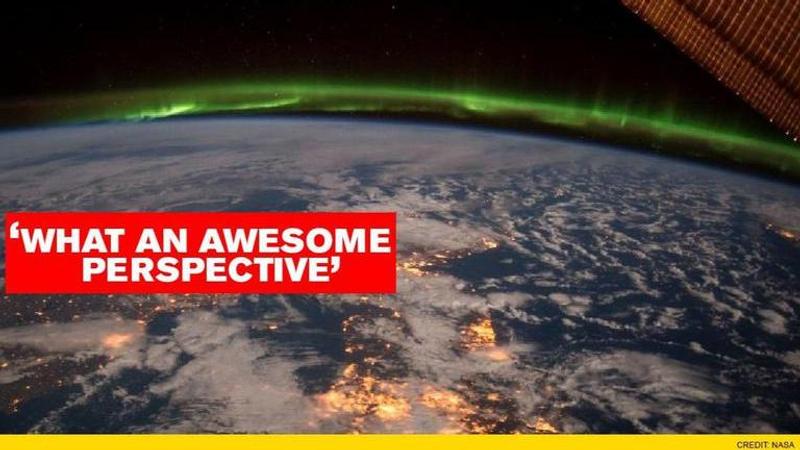Published 13:57 IST, September 10th 2020
Astronaut captures spectacular view of river Nile at night from ISS; See pics
The image, shared by astronaut Chris Cassidy was captured during ISS’ nighttime flyover above Cairo, Egypt that depicts glowy human settlements along Nile.

Advertisement
A NASA astronaut recently shared the spectacular view of the Nile river from the International Space station, captured in the night. The image, shared by astronaut Chris Cassidy was captured during ISS’ nighttime flyover above Cairo, Egypt. On September 9, taking to his official Twitter handle, Cassify shared the mesmeric picture of the river Nile with vibrant glow also ver with a caption, saying, water is life and that can be ascertained nowhere better than River Nile.
Cassidy shared two images of the Nile delta region, as it appears glowy in the murky dark region. In the images, one could see the Egyptian population almost completely concentrated along the Nile Valley, concentrated about a small percentage of the country’s land area. The Nile can be seen lightened along the brilliant, long-stemmed stream of water in the southeastern Mediterranean Sea. Also, the Cairo metropolitan area can be seen in the shape of a bright lit complex network of city lights, demonstrating the human settlement in the region.
Water is life and nowhere on the planet is that more evident than the Nile River at night. #NileRiver #Egypt #Cairo pic.twitter.com/CWpiR8EnBn
— Chris Cassidy (@Astro_SEAL) September 8, 2020
“The smaller cities and towns within the Nile Delta tend to be hard to see amidst the dense agricultural vegetation during the day,” NASA said about one other photo of the Nile captured by astronaut Kelly, photographed past the halfway mark of his one-year mission to the International Space Station.
Nice that you also captured Scorpius just over the horizon and the #NileRiver. Here is my pic of the same constellation🦂, but of course from Earth🌎and 180° rotated with respect to yours.
— Alejandro Gangui (@algangui) September 8, 2020
See it? pic.twitter.com/oowvGi0uZa
Wow good job!!
— Waleed bin Khalid 🇵🇰 🅙 (@WaleedVibes) September 9, 2020
What an awesome perspective on the 2nd shot...WOW !! ...time for some tea and a water pipe ?! #Hukkah @DaveAtCOGS
— MillG ...masking the benefit of a mask sb unmasked (@grainreader) September 8, 2020
Your photo can serve as an evidence that the upper #Nile county #Ethiopia still is in darkness even if 86% of the water share comes from her. #TimeToFinishtheDam #GERD #EthiopiaNileRights
— መSፍን ተ® (@mesfin_t) September 9, 2020
Hi brother... that second shot! Good angle. Interesting red sheen, gives it an extra mysterious look.
— Jennifer Eileen Swarts E. E. M. P. (@JUNIPERTREE20) September 8, 2020
Hope you're well.
I've lost count for return...how many days now?
🌈🌳
Wow. Looks absolutely astonishing from space. Even though on the ground it is an absolute catastrophe.
— Joe (@michou_94) September 9, 2020
The river Abaye(Nile )is still the heart of Ethiopia .This is the time to understand the truth.
— yohannes (@yohanne08940524) September 9, 2020
Human settlements visible from ISS
NASA explained that the lights were, in fact, the “settled areas and the connecting roads between them become clearly visible at night.” Likewise, NASA added, the urbanized regions and infrastructure along the Nile River becomes apparent in the dark in ISS photographs. Kelly had photographed the Nile River during a nighttime flyover on September 22, 2015. Kelly (@StationCDRKelly) wrote, “Day 179. The #Nile at night is a beautiful sight for these sore eyes. Good night from @space_station! #YearInSpace.” Users were rendered mesmerized at the pictures that they described as “giving different perspectives” and acknowledged the importance of the river Nile that provided for almost 86 percent of the Egyptian population.
[The Nile River and its delta look like a brilliant, long-stemmed flower in this astronaut photograph of the southeastern Mediterranean Sea at night. Credit: ISS/NASA]
[A closer view of river Nile shot from ISS at night. Credit: NASA]
13:57 IST, September 10th 2020





